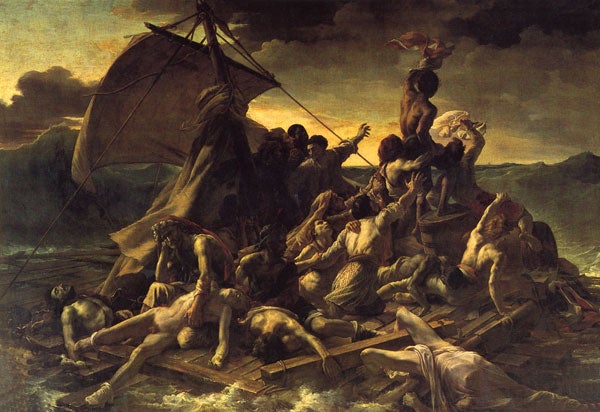Great Works: The Raft of the Medusa 1819 (491x716 cm), Théodore Géricault
Musée du Louvre, Paris

There are great paintings, which seem to contain with themselves many other paintings, tumultuous scenes that harbour a wide range of concerns, themes, manners of depiction, and even points of view. Théodore Géricault's sensational masterpiece The Raft of the Medusa is one such painting. It is both a painting that seems to echo classical poses, and, in the same breath, a subverter of those same ideals, solidly in the Romantic tradition. It is a history painting on the grandest of grand scales, but it lacks identifiable heroes. Its beauty lies in its horror. It is a painting which the eye can easily divide into smaller and ever smaller units, each one of which requires – perhaps even seems to demand – feverish attention from the onlooker, quite as feverish as the terrible ocean, which is buffeting the doomed raft itself. It contains a muscular figure study here, a still life there. It is a painting of tumultuous bodies, reaching out, turning, twisting, contorting, many seemingly in desperate conflict with each other, which coheres as if by some miracle. It could so easily not have cohered, we think. There is so much of it, and it engulfs the eye to such an extent – it is almost as if the eye (mimicking the raft itself) seems to drown in it, as if the ocean is threatening to upend the raft in our direction so that this horrifying mess will shortly be our mess. Such is our horrified absorption. Such is this vertiginous scene of terrible and uncontrollable chaos, with its oceanic rocking motion.
The work began in a highly sensational news story, and Géricault began to prepare for its making with a welter of figure drawings – at least one hundred, scholars currently calculate. He also made a tiny wooden model of the raft, on which he placed figures, modelled in wax. Its theme is the aftermath of a terrible shipwreck, which happened three years before the painting was made. A navy frigate called Medusa ran aground on a sandy reef off the West Coast of Africa. The fortunate passengers were off-loaded on to the ship's boats, the less fortunate on to a raft, which was later, quite deliberately, cast adrift. The majority perished. There is so much here: heroism, terror, resignation, horror, optimism, pessimism. Is not the man who is being borne aloft by his desperate comrades, the one who is furiously brandishing that red fragment of clothing or pennant in a kind of desperate apex of optimism, still living in hope of rescue? Is there not a tiny triple-master, the tiniest of specks, on the horizon? Oh, but it is so hopelessly far away!
And yet there is the opposite of this mood too, on the other end of that ever weakening and ever-shifting frame of wooden planks. Is not the man in the foreground, he whose head is resting with exhausted resignation on the heel of his hand, and whose other hand claws at a beautiful naked corpse whose leg hangs over that of another, as if to give some meagre comfort to the naked dead, the very embodiment of doomed pessimism? There is a strange stillness in that face which stares, rapt, into the middle distance, hoping nothing.
So within the space of the width of half a canvas our hopes rise, and are then cruelly dashed again. There is another very sobering detail that catches our eye too: that partial sighting we get of what may be the only woman in this scene of wrenching, tormented male bodies. She is there at bottom right, one leg hooked over a broken plank. Woman? Can we really be sure that it is a woman? Well, are not those her nipples that you can see through the diaphanous white garment, which the waves have carried back over her head, almost as if to show her some modicum of respect by hiding her drowned face from us?
But it is the light in this painting which finally condemns these human beings to death. We have seldom witnessed such a ghoulish, knell-tolling light. Look how dark the enveloping atmosphere is, how suffused with the sickly smearily ghoulish green-brown-yellow of the charnel house. That dominant tone almost reeks of death, decay – the dying of the light of day, and the dying of the light of life simultaneously.
But it is a parable too, this masterpiece of almost wincingly cinematic pity and horror. Although inspired by a particular occasion, it is also a universal story of hazarding. We too, we feel as we look and look at it, live our lives so precariously, as precariously as doomed survivors who hope to remain upright and alive and ever optimistically waving on some doomed raft in mid-ocean. We are pitched and tossed about so wantonly. Our moods, our financial instabilities, buffet us back and forth. We find ourselves rejoicing over some petty triumph over adversity one day, and weeping the next.
ABOUT THE ARTIST
Théodore Géricault (1791-1824) was one of the most disturbing figures of French Romanticism. His preoccupation with death, violence, monomania and extreme psychological states make his paintings and lithographs both horrifying and utterly compelling.
Join our commenting forum
Join thought-provoking conversations, follow other Independent readers and see their replies
Comments